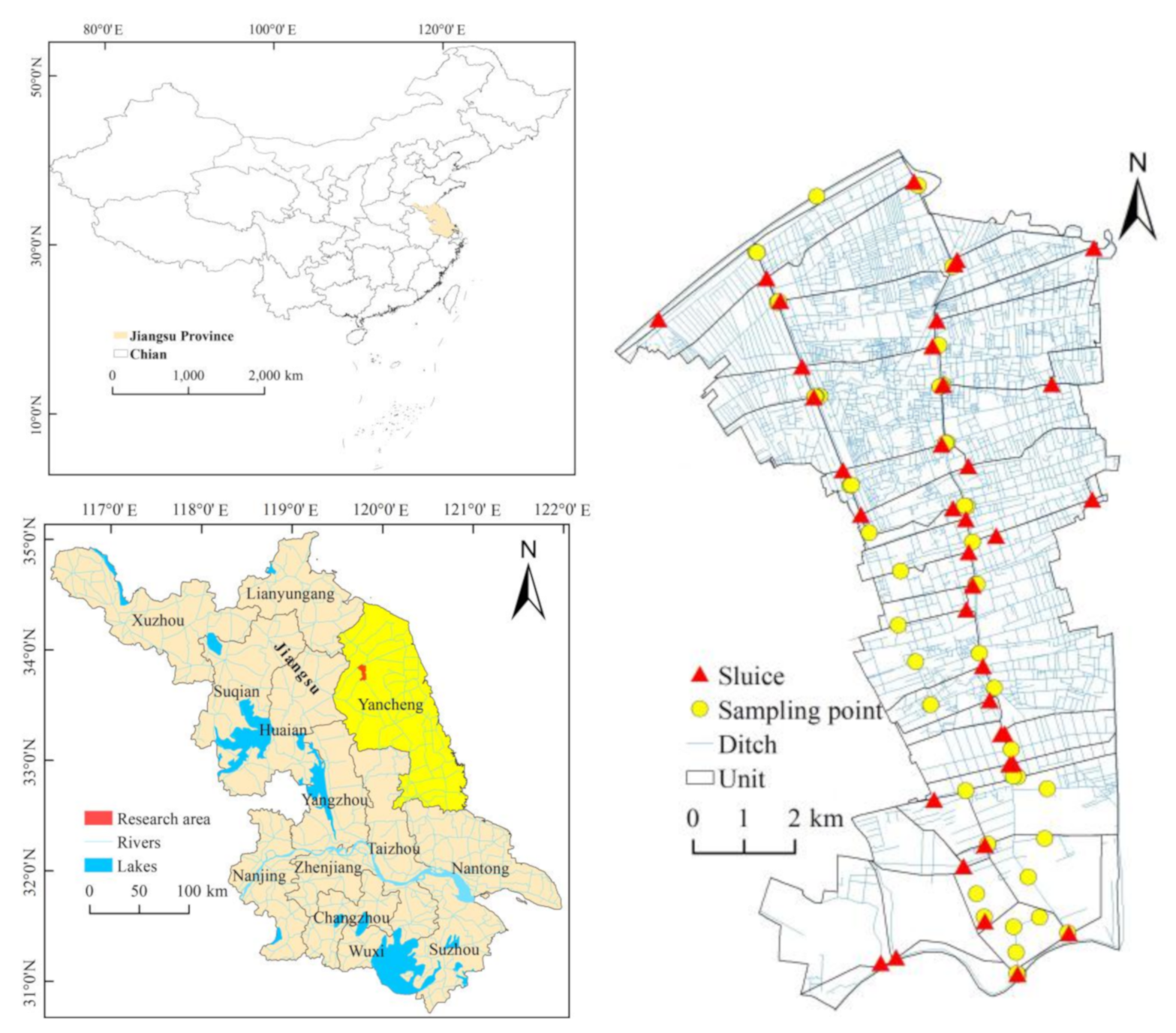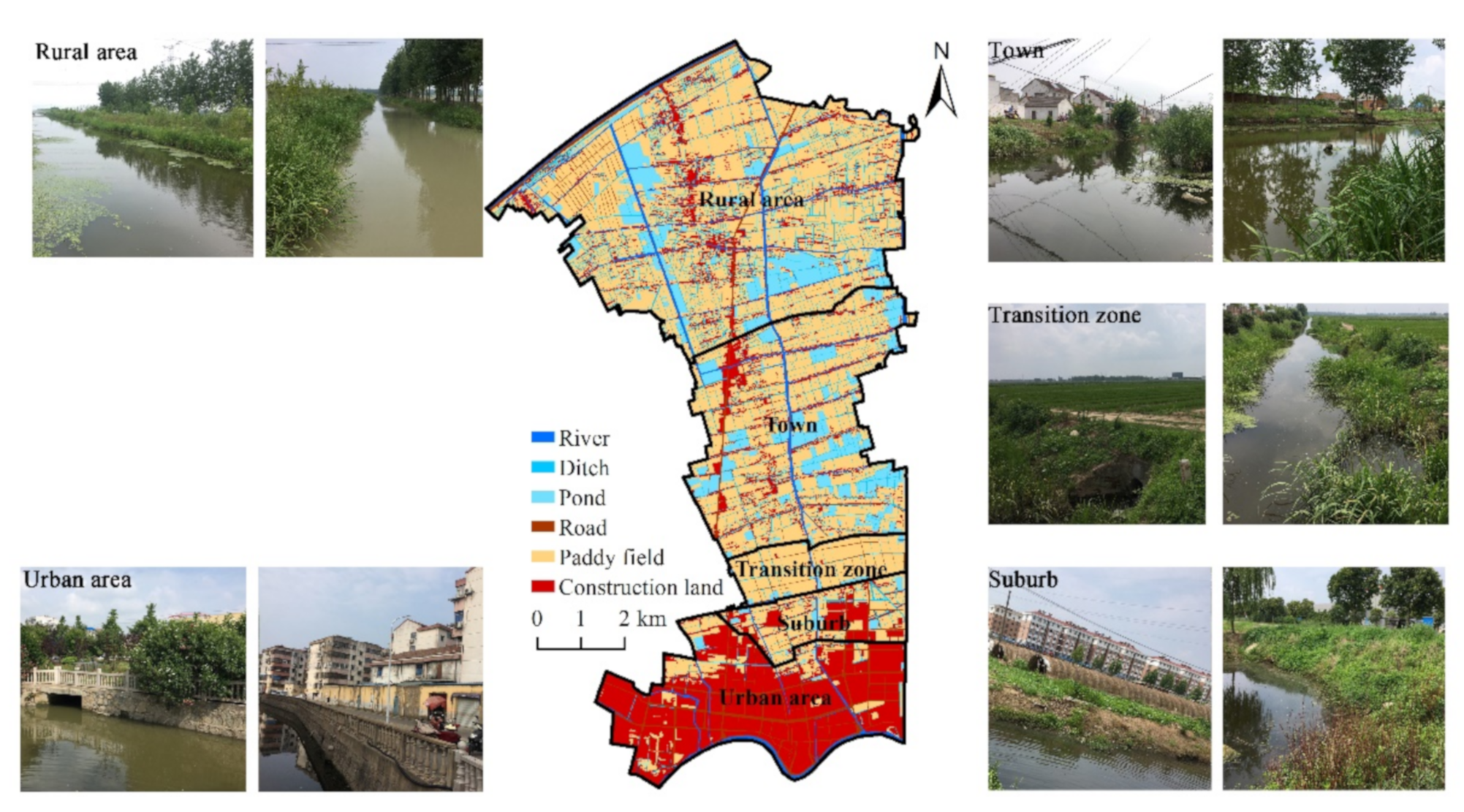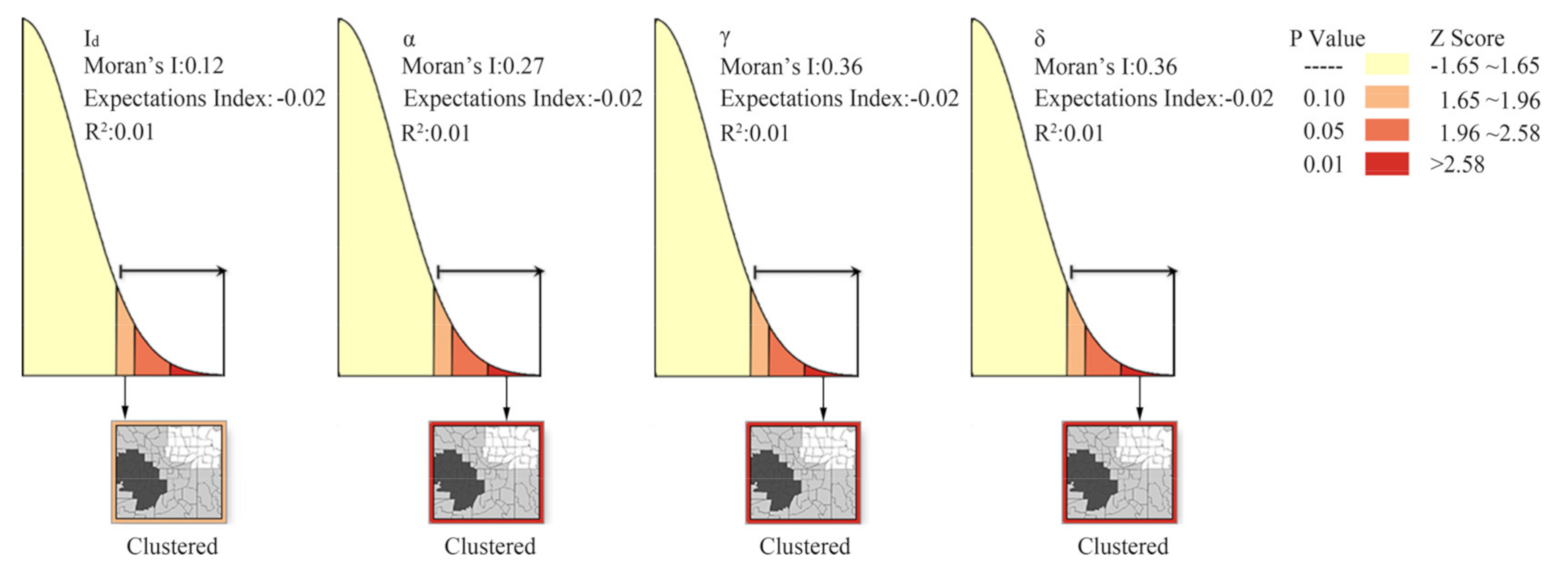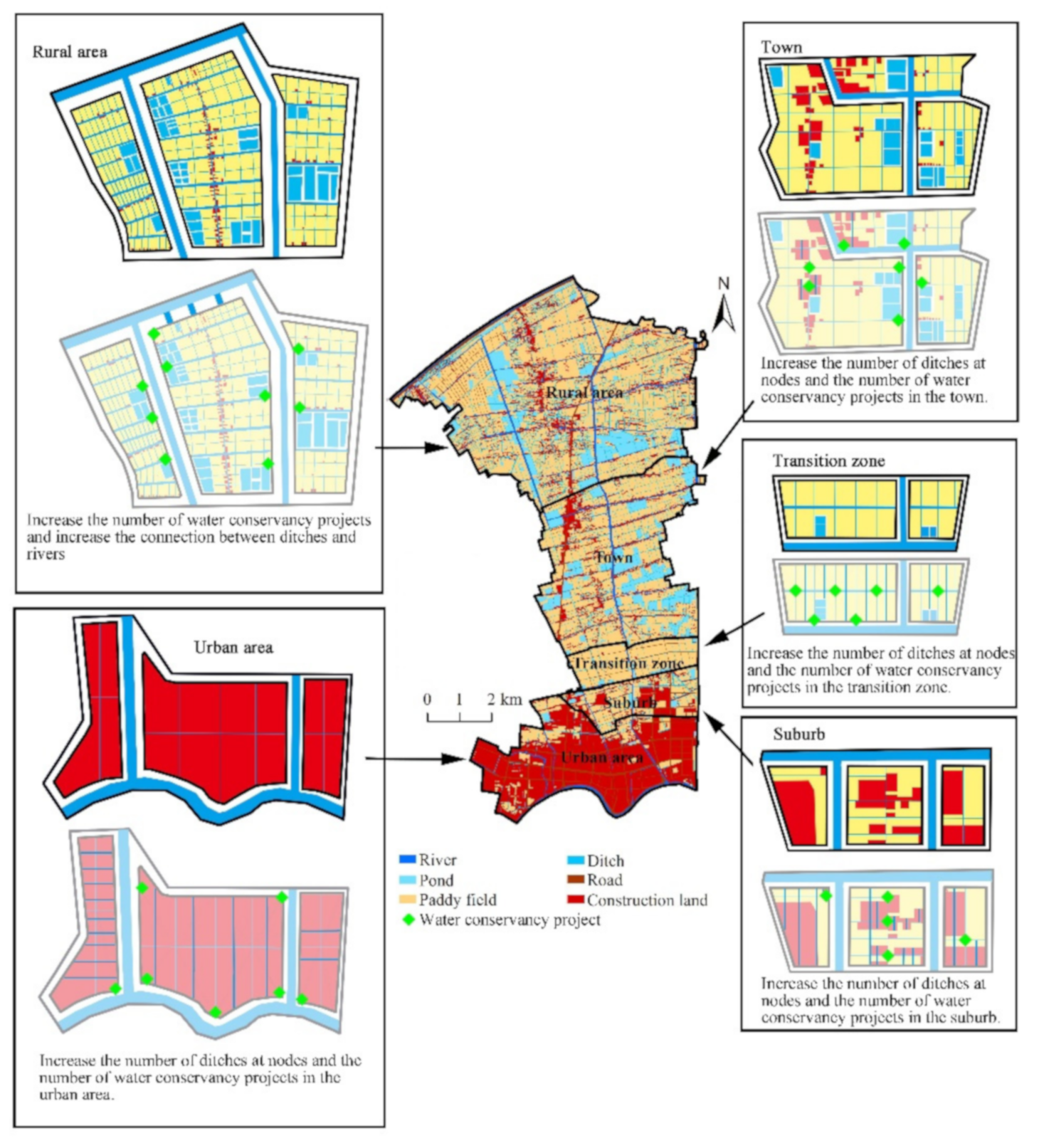Spatial Effects of Urban-Rural Ditch Connectivity Gradient Changes on Water Quality to Support Ditch Optimization and Management
Abstract
:1. Introduction
2. Materials and Methods
2.1. Study Area
2.2. Datasets
2.2.1. Remote Sensing Data Processing
2.2.2. Urban-Rural Gradient Division
2.2.3. Water Quality Data Collection
- (1)
- Sampling sites.
- (2)
- Sample collection and lab analysis.
2.3. Methodology
2.3.1. Selection of Ditch Connectivity Index
- (1)
- Ditch density (Id): Id represented the length of the ditch per square kilometer. The ditch density was the basic index of ditch network structure. The greater the density of the ditch, the more frequent the interaction between land and water. The calculation formula is [17]:where Lj is the length of the j-th ditch in the study area, j = 1, 2, …, N; A is the area of the study area.
- (2)
- Circularity (α): It can describe the choice of energy flow, logistics, and species migration routes in the network. It was a good indicator of network complexity and reflects the nutrient exchange capacity of nodes in the ditch network. The value of α is 0–1. When α = 0, it means no loop; when α = 1, it has the largest number of loops and the strongest nutrient exchange capacity. The calculation formula is [18]where M is the number of ditch corridors; V is the number of nodes in the study area.
- (3)
- Network connectivity (γ): It respected the degree of nodes connectivity in the network system. The range of γ is 0–1. When γ = 0, it indicates that the nodes are not connected; When γ = 1, it means that each node is connected to other nodes, and the network connection is the best. The calculation formula is [19]where M represents the number of ditches; V is the number of nodes in the study area.
- (4)
- Water conservancy project index (δ): The pumping station was mainly used to pump water resources from lower areas to higher areas of the study area. Culverts in the ditches were mainly located below the road and when the width of ditches became narrow so the ditch connectivity was affected by culverts. According to the location of the water conservancy project and the levels of connected ditches, the weights are assigned by the expert grading method, with a large impact value of 0.7 and a less impact value of 0.3 [20,21].The calculation formula is:where a1 and a2 represent the number of water conservancy projects with larger and smaller impacts in each calculation unit respectively.
2.3.2. Water Quality Index
2.3.3. Analysis of Spatial Autocorrelation
2.3.4. Geographically Weighted Regression (GWR) Analysis
3. Results
3.1. The Spatial Difference of the Ditch Connectivity
3.2. Spatial Heterogeneity of Water Quality Index
3.3. Regression Model of Ditch Connectivity Index and Water Quality Index
4. Discussion
4.1. Spatial Autocorrelation Analysis of Ditch Connectivity Indicators
4.2. Spatial Autocorrelation Analysis of Water Quality Index
4.3. GWR Goodness of Fit and Residual Distribution
4.4. The Spatial Management Patterns of Ditches to Improve Water Quality
5. Conclusions
Author Contributions
Funding
Institutional Review Board Statement
Informed Consent Statement
Data Availability Statement
Acknowledgments
Conflicts of Interest
References
- Ma, L.; He, F.; Sun, J.; Wang, L.; Xu, D.; Wu, Z. Remediation effect of pond-ditch circulation on rural wastewater in southern China. Ecol. Eng. 2015, 77, 363–372. [Google Scholar] [CrossRef]
- Kong, X.; Wang, S.; Liu, B.; Sun, H.; Sheng, Z. Impact of water transfer on interaction between surface water and groundwater in the lowland area of North China Plain. Hydrol. Process. 2018, 32, 2044–2057. [Google Scholar] [CrossRef]
- Xue, L.; Hou, P.; Zhang, Z.; Shen, M.; Liu, F.; Yang, L. Application of systematic strategy for agricultural non-point source pollution control in Yangtze River basin, China. Agric. Ecosyst. Environ. 2020, 304, 107148. [Google Scholar] [CrossRef]
- Marara, T.; Palamuleni, L.G. An environmental risk assessment of the Klip river using water quality indices. Phys. Chem. Earth 2019, 114, 102799. [Google Scholar] [CrossRef]
- Smith, J.S.; Winston, R.J.; Tirpak, R.A.; Wituszynski, D.M.; Boening, K.M.; Martin, J.F. The seasonality of nutrients and sediment in residential stormwater runoff: Implications for nutrient-sensitive waters. J. Environ. Manag. 2020, 276, 111248. [Google Scholar] [CrossRef]
- Zhao, M.M.; Chen, Y.-p.; Xue, L.-g.; Fan, T.T. Three kinds of ammonia oxidizing microorganisms play an important role in ammonia nitrogen self-purification in the Yellow River. Chemosphere 2020, 243, 125405. [Google Scholar] [CrossRef] [PubMed]
- Lutgen, A.; Jiang, G.; Sienkiewicz, N.; Mattern, K.; Kan, J.; Inamdar, S. Nutrients and Heavy Metals in Legacy Sediments: Concentrations, Comparisons with Upland Soils, and Implications for Water Quality. JAWRA J. Am. Water Resour. Assoc. 2020, 56, 669–691. [Google Scholar] [CrossRef]
- Deng, X. Correlations between water quality and the structure and connectivity of the river network in the Southern Jiangsu Plain, Eastern China. Sci. Total Environ. 2019, 664, 583–594. [Google Scholar] [CrossRef] [PubMed]
- Jianxin, H.; Dongying, W. Research on the Comprehensive Evaluation System for River in Jiangsu Province Coastal Areas. Procedia Soc. Behav. Sci. 2013, 96, 1025–1029. [Google Scholar] [CrossRef] [Green Version]
- Wang, H.; Ji, F.Q.; Zhou, Y.Y.; Xia, K. Water Pollutant Control for a River-Lake Region to the Northwest of Lake Taihu. Appl. Mech. Mater. 2014, 3517, 420–425. [Google Scholar] [CrossRef]
- Sun, H.; Cheng, X.; Dai, M. Regional flood disaster resilience evaluation based on analytic network process: A case study of the Chaohu Lake Basin, Anhui Province, China. Nat. Hazards 2016, 82, 39–58. [Google Scholar] [CrossRef]
- Fork, M.L.; Blaszczak, J.R.; Delesantro, J.M.; Heffernan, J.B. Engineered headwaters can act as sources of dissolved organic matter and nitrogen to urban stream networks. Limnol. Oceanogr. Lett. 2018, 3, 215–224. [Google Scholar] [CrossRef]
- State Environmental Protection Administration. Methods of Monitoring and Analyzing for Water and Wastewater, 4th ed.; China Environmental Science Press: Beijing, China, 2002. [Google Scholar]
- Wang, L.; Xu, Y.; Yu, M. River system connectivity analysis of Wuxi0027s central urban area based on graph theory. In Advances in Hydrology and Hydraulic Engineering, Parts 1 and 2; Jiang, C.B., Yang, Z.J., Eds.; Applied Mechanics and Materials: Nanjing, China, 2012; Volume 212–213, pp. 543–548. [Google Scholar]
- Dai, X.; Xu, Y.; Lin, Z.; Wang, Q.; Gao, B.; Yuan, J.; Xiang, J. Influence of changes in river system structure on hydrological processes in Taihu Basin, China. Hydrol. Sci. J. J. Des. Sci. Hydrol. 2019, 64, 2093–2104. [Google Scholar] [CrossRef]
- Deng, X.; Xu, Y.; Han, L. Impacts of human activities on the structural and functional connectivity of a river network in the Taihu Plain. Land Degrad. Dev. 2018, 29, 2575–2588. [Google Scholar] [CrossRef]
- Lin, Z.; Xu, Y.; Dai, X.; Wang, Q.; Gao, B.; Xiang, J.; Yuan, J. Changes in the plain river system and its hydrological characteristics under urbanization—Case study of Suzhou City, China. Hydrol. Sci. J. J. Des. Sci. Hydrol. 2019, 64, 2068–2079. [Google Scholar] [CrossRef]
- Cui, B.; Wang, C.; Tao, W.; You, Z. River channel network design for drought and flood control: A case study of Xiaoqinghe River basin, Jinan City, China. J. Environ. Manag. 2009, 90, 3675–3686. [Google Scholar] [CrossRef]
- Li, X.-q.; Hua, Z.-l. Multiphase distribution and spatial patterns of perfluoroalkyl acids (PFAAs) associated with catchment characteristics in a plain river network. Chemosphere 2021, 263, 128284. [Google Scholar] [CrossRef]
- Wang, J.; Yan, H.; Xin, K.; Tao, T. Risk assessment methodology for iron stability under water quality factors based on fuzzy comprehensive evaluation. Environ. Sci. Eur. 2020, 32, 1–9. [Google Scholar] [CrossRef]
- Huang, Y.; Zeng, Y.; Liu, S.; Ma, Y.; Xu, X. Community Structure of Aquatic Community and Evaluation of Water Quality in Laovingyan Section of Dadu River. Huan Jing Ke Xue Huanjing Kexue 2016, 37, 132–140. [Google Scholar]
- Nong, X.; Shao, D.; Zhong, H.; Liang, J. Evaluation of water quality in the South-to-North Water Diversion Project of China using the water quality index (WQI) method. Water Res. 2020, 178, 115781. [Google Scholar] [CrossRef]
- Derdour, A.; Ali, M.M.M.; Sari, S.M.C. Evaluation of the quality of groundwater for its appropriateness for drinking purposes in the watershed of Naama, SW of Algeria, by using water quality index (WQI). SN Appl. Sci. 2020, 2, 1–14. [Google Scholar] [CrossRef]
- Chang, H.; Psaris, M. Local landscape predictors of maximum stream temperature and thermal sensitivity in the Columbia River Basin, USA. Sci. Total Environ. 2013, 461–462, 587–600. [Google Scholar] [CrossRef]
- Wang, Z.; Zhong, J.; Lan, H.; Wang, Z.; Sha, Z. Association analysis between spatiotemporal variation of net primary productivity and its driving factors in inner mongolia, china during 1994–2013. Ecol. Indic. 2019, 105, 355–364. [Google Scholar] [CrossRef]
- Pratt, B.; Chang, H. Effects of land cover, topography, and built structure on seasonal water quality at multiple spatial scales. J. Hazard. Mater. 2012, 209, 48–58. [Google Scholar] [CrossRef] [PubMed]
- Tu, J.; Xia, Z.-G. Examining spatially varying relationships between land use and water quality using geographically weighted regression I: Model design and evaluation. Sci. Total Environ. 2008, 407, 358–378. [Google Scholar] [CrossRef] [PubMed]
- Park, S.-R.; Lee, S.-W. Spatially Varying and Scale-Dependent Relationships of Land Use Types with Stream Water Quality. Int. J. Environ. Res. Public Health 2020, 17, 1673. [Google Scholar] [CrossRef] [Green Version]
- Xiaoping, W.; Fei, Z. Multi-scale analysis of the relationship between landscape patterns and a water quality index (WQI) based on a stepwise linear regression (SLR) and geographically weighted regression (GWR) in the Ebinur Lake oasis. Environ. Sci. Pollut. Res. Int. 2018, 25, 7033–7048. [Google Scholar]
- Omorogieva, O.M.; Imasuen, O.I.; Isikhueme, M.I.; Ehinlaye, O.A.; Anegbe, B.; Ikponmwen, M.O. Hydrogeology and Water Quality Assessment (WQA) of Ikhueniro and Okhuahe Using Water Quality Index (WQI). J. Geogr. Environ. Earth Sci. Int. 2016, 6, 1–10. [Google Scholar] [CrossRef]
- Shen, J.; Jun, Z.; Shang, L. Analysis of the impact of landscape pattern change on the river network connectivity based on the spatial auto-regressive model. J. East China Norm. Univ. (Nat. Sci.) 2015, 2015, 124–135. [Google Scholar]
- Jin, Y. The Study of River Network Structural Changes and Space Partition in South of Yangtze River: A Case study of Qingpu, Shanghai. Master’s Thesis, East China Normal University, Shanghai, China, 2013. [Google Scholar]
- Persic, V.; Horvatic, J. Spatial Distribution of Nutrient Limitation in the Danube River Floodplain in Relation to Hydrological Connectivity. Wetlands 2011, 31, 933–944. [Google Scholar] [CrossRef]
- Zhao, D. Landslide Disaster Ecological Risk of Small Watershed Honghe Hani Rice Terraces World Heritage Site by Means of Susceptibility and Connectivity. Master’s Thesis, Yunnan Normal University, Kunming, China, 2020. [Google Scholar]
- Ha, H.J.; Hee, P.S.; Min, S.C. A Study on an Integrated Water Quantity and Water Quality Evaluation Method for the Implementation of Integrated Water Resource Management Policies in the Republic of Korea. Water 2020, 12, 2346. [Google Scholar]
- Wang, W. The Application of Different Water Quality Evaluation Methods in Water Quality Assessment of Lancang River Source Region. J. Low Carbon Econ. 2015, 4, 30. [Google Scholar]
- Bhat, S.U.; Pandit, A.K. Water quality assessment and monitoring of Kashmir Himalayan freshwater springs-A case study. Aquat. Ecosyst. Health Manag. 2020, 23, 274–287. [Google Scholar] [CrossRef]
- Zheng, K.Z.; Xue, C. Application research of single factor index method in water quality evaluation. Groundwater 2018, 40, 79–80. [Google Scholar]
- Guo, J.W.; Huang, D.Z. Pollution characterization and water quality assessment of Dongting Lake. Environ. Chem. 2019, 38, 152–160. [Google Scholar]
- Mohammed, F.M.A.; Saadi, R.J.M.A.; Fawzy, A.M.A.; Ali, S.H.M.; Mutasher, A.K.A.; Hommadi, A.H. The Analysis of Water Quality Using Canadian Water Quality Index: Green Belt Project/Kerbala-Iraq. Int. J. Des. Nat. Ecodyn. 2021, 16, 91–98. [Google Scholar] [CrossRef]
- Ning, Y.; Yin, F. Water quality evaluation based on improved Nemerow pollution index method and grey clustering method. J. Cent. China Norm. Univ. Nat. Sci. Ed. 2020, 54, 149–155. [Google Scholar]
- Gagandeep, K.; Richa, K.; Sunil, D.; Deepak, P.; Tyagi, Y.Y. Impact assessment on water quality in the polluted stretch using a cluster analysis during pre- and COVID-19 lockdown of Tawi river basin, Jammu, North India: An environment resiliency. Energy Ecol. Environ. 2021, 1–12. [Google Scholar] [CrossRef]
- Ding, Y.; Zhao, J.-Y.; Zhang, J.; Fu, Y.-C.; Peng, W.-Q.; Chen, Q.-C.; Li, Y.-Y. Spatial Differences in Water Quality and Spatial Autocorrelation Analysis of Eutrophication in Songhua Lake. Huan Jing Ke Xue Huanjing Kexue 2021, 42, 2232–2239. [Google Scholar] [CrossRef]
- Liu, S. Situation and Control Effect of Agricultural Non-Point Source Pollution in Typical Small Watershed of Fengle River. Master’s Thesis, Anhui Agricultural University, Hefei, China, 2020. [Google Scholar]
- Yang, Y. Quality Assessment and Improvement Countermeasures of Countryside Drinking Water Source in Taian City. Master’s Thesis, Shandong Agricultural University, Taian, China, 2008. [Google Scholar]










| WQI | Water Quality Level | Classification Standard |
|---|---|---|
| ≤20 | Great (I) | Most targets were not detected, and the detected values were within the standard |
| 20–40 | Good (II) | The detected values were within the standard |
| 40–70 | Medium (III) | Most values were within the standard, and one target was close to or exceed the standard |
| 70–100 | Slightly polluted (IV) | Two detected values exceed the standard |
| >100 | Heavy polluted (V) | Most of the detected values exceeded the standard |
| Independent Variable | Average | Maximum | Minimum | Upper Quartile | Lower Quartile | Median |
|---|---|---|---|---|---|---|
| Id | −0.22 | 0.21 | −0.44 | −0.38 | −0.06 | −0.31 |
| α | −168.66 | −147.58 | −201.69 | −179.08 | −156.43 | −166.32 |
| γ | 118.94 | 141.86 | 95.50 | 105.65 | 129.65 | 120.25 |
| Δ | −0.63 | −0.09 | −0.91 | −0.85 | −0.43 | −0.71 |
| Moran’s I | Expectation Index | R2 | Z Score | p Value | Result | |
|---|---|---|---|---|---|---|
| Water quality index | 0.66 | −0.02 | 0.01 | 7.14 | 0.00 | Clustering |
| Variable | Residual Squares | Effective Number | Sigma | AICc | R2 | R2 Adjusted |
|---|---|---|---|---|---|---|
| Parameter | 4961.68 | 10.19 | 11.77 | 370.92 | 0.63 | 0.53 |
Publisher’s Note: MDPI stays neutral with regard to jurisdictional claims in published maps and institutional affiliations. |
© 2021 by the authors. Licensee MDPI, Basel, Switzerland. This article is an open access article distributed under the terms and conditions of the Creative Commons Attribution (CC BY) license (https://creativecommons.org/licenses/by/4.0/).
Share and Cite
Qiu, C.; Li, Y.; Wright, A.L.; Wang, C.; Xu, J.; Zhou, S.; Huang, W.; Wu, Y.; Zhang, Y.; Liu, H. Spatial Effects of Urban-Rural Ditch Connectivity Gradient Changes on Water Quality to Support Ditch Optimization and Management. Sustainability 2021, 13, 8329. https://doi.org/10.3390/su13158329
Qiu C, Li Y, Wright AL, Wang C, Xu J, Zhou S, Huang W, Wu Y, Zhang Y, Liu H. Spatial Effects of Urban-Rural Ditch Connectivity Gradient Changes on Water Quality to Support Ditch Optimization and Management. Sustainability. 2021; 13(15):8329. https://doi.org/10.3390/su13158329
Chicago/Turabian StyleQiu, Chunqi, Yufeng Li, Alan L. Wright, Cheng Wang, Jiayi Xu, Shiwei Zhou, Wanchun Huang, Yanhui Wu, Yinglei Zhang, and Hongyu Liu. 2021. "Spatial Effects of Urban-Rural Ditch Connectivity Gradient Changes on Water Quality to Support Ditch Optimization and Management" Sustainability 13, no. 15: 8329. https://doi.org/10.3390/su13158329
APA StyleQiu, C., Li, Y., Wright, A. L., Wang, C., Xu, J., Zhou, S., Huang, W., Wu, Y., Zhang, Y., & Liu, H. (2021). Spatial Effects of Urban-Rural Ditch Connectivity Gradient Changes on Water Quality to Support Ditch Optimization and Management. Sustainability, 13(15), 8329. https://doi.org/10.3390/su13158329






